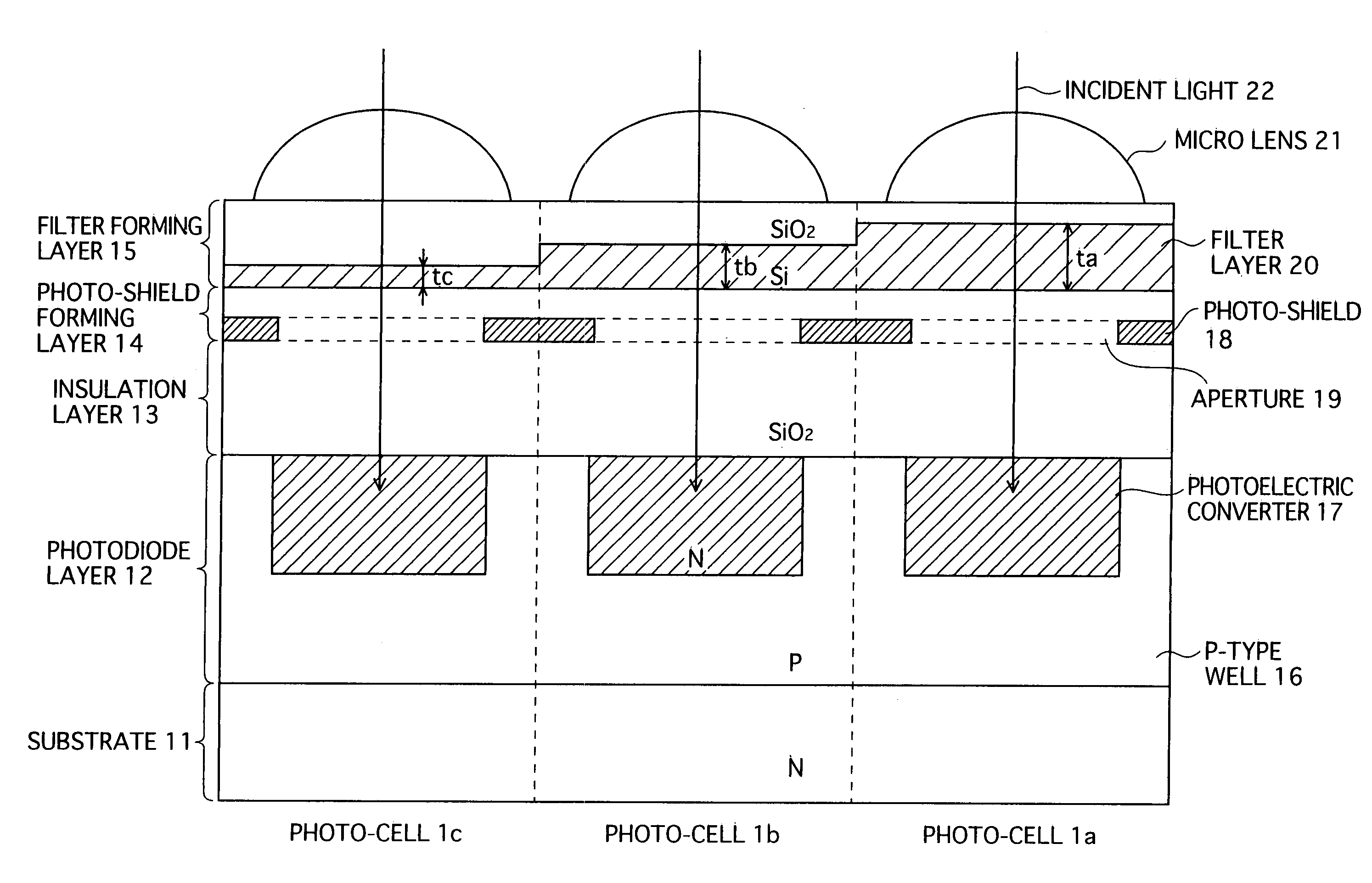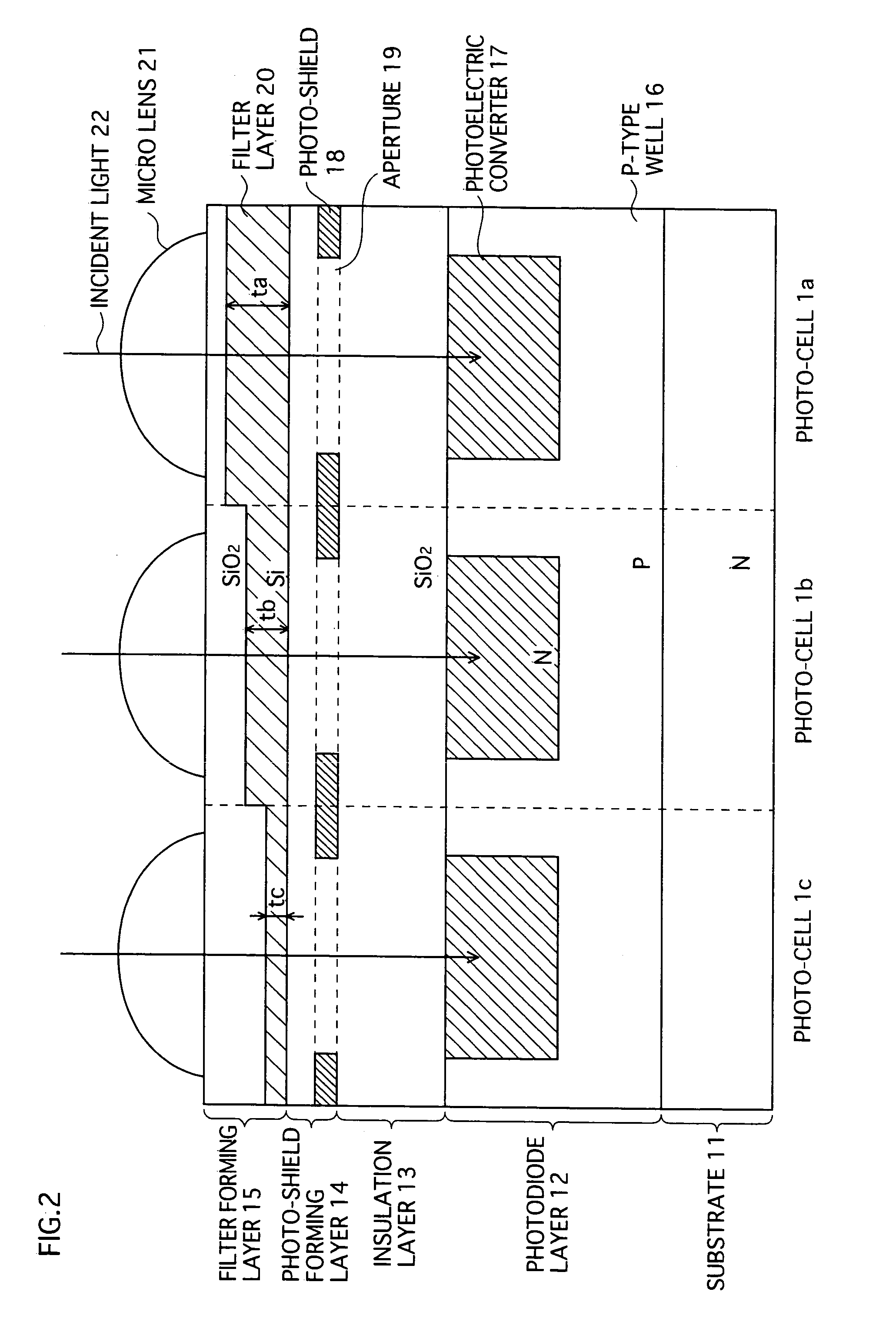Photodetector
a technology of photodetectors and detectors, applied in the field of photodetectors, can solve the problems of reducing the cost of photodetectors, and achieve the effect of simplifying the manufacturing process
- Summary
- Abstract
- Description
- Claims
- Application Information
AI Technical Summary
Benefits of technology
Problems solved by technology
Method used
Image
Examples
first embodiment
[outline]
[0076] In a first embodiment, filter layers in all pixel cells are made only of polysilicon. As a characteristic of polysilicon, a wavelength range of light to be transmitted through a polysilicon layer varies according to the thickness of the layer. Therefore, it is possible to use the polysilicon filter layers as color filters by setting a thickness of polysilicon for each photo-cell is different from cell to cell.
[0077] Because the wavelength range of light to be transmitted through a polysilicon filter layer is determined based on the thickness of the corresponding filter layer, instead of pigments or dyestuff for each color, it is not necessary to control material for the pigments or dyestuff of different colors in manufacturing the filter layers. Therefore, the production cost can be reduced.
[0078] In addition, the filter layers can be manufactured using a semiconductor fabrication technology, and a color filter manufacturing process that manages acrylic resins is ...
second embodiment
[Outline]
[0156] In a second embodiment, the filter forming layer 15 is formed below the photo-shield forming layer 14, and the insulation layer 13 that insulates between the filter forming layer 15 and the photodiode layer 12 is formed so as to have a thickness in a range of 1 nm to 150 nm. With photo-cells having such a structure, reflections of the incident light 22 at boundaries between layers become smaller, and as a result, it is possible to suppress a decrease in sensitivity.
[Structure]
[0157] FIG.7 is a sectional view of photo-cells (1a, 1b, 1c) according to the second embodiment.
[0158] The photo-cells according to the second embodiment each include the substrate 11, the photodiode layer 12, the insulation layer 13, the photo-shield forming layer 14, and the filter forming layer 15. A difference from the photo-cells according to the first embodiment is that the filter forming layer 15 is formed between the photo-shield forming layer 14 and the insulation layer 13. Other th...
third embodiment
[Outline]
[0171] In a third embodiment, the insulation layer 13 between the filter layer 20 and the photodiode layer 12 is removed from the photo-cells in order to improve the sensitivity of the photo-cells. However, simply removing the insulation layer 13 causes another problem that the signal charge generated in the photoelectric converter 17 leak to the filter layer 20. Therefore, a potential barrier 23 is disposed between the photoelectric converter 17 and the filter layer 20 so as to prevent the signal charges from leaking. By this, it is possible to completely eliminate the reflection at the boundary between the insulation layer 13 and the photodiode layer 12.
[Structure]
[0172] FIG.8 is a sectional view of photo-cells (1a, 1b, 1c) according to a third embodiment.
[0173] The photo-cells each include the substrate 11, the photodiode layer 12, the photo-shield forming layer 14, and the filter forming layer 15. A difference from the photo-cells according to the second embodiment ...
PUM
 Login to View More
Login to View More Abstract
Description
Claims
Application Information
 Login to View More
Login to View More - R&D
- Intellectual Property
- Life Sciences
- Materials
- Tech Scout
- Unparalleled Data Quality
- Higher Quality Content
- 60% Fewer Hallucinations
Browse by: Latest US Patents, China's latest patents, Technical Efficacy Thesaurus, Application Domain, Technology Topic, Popular Technical Reports.
© 2025 PatSnap. All rights reserved.Legal|Privacy policy|Modern Slavery Act Transparency Statement|Sitemap|About US| Contact US: help@patsnap.com



